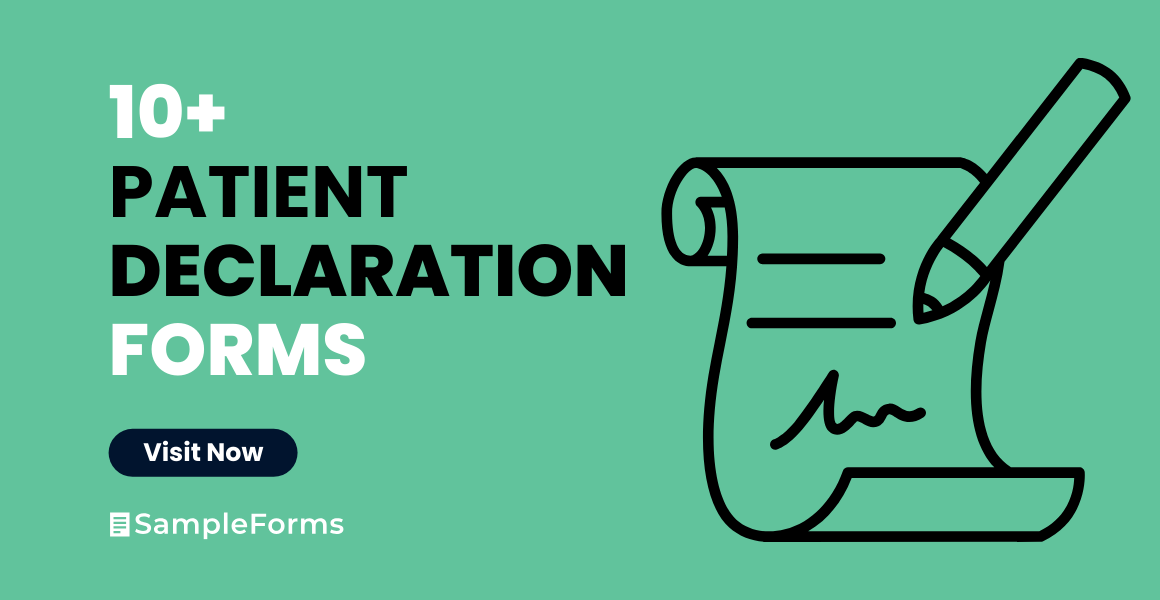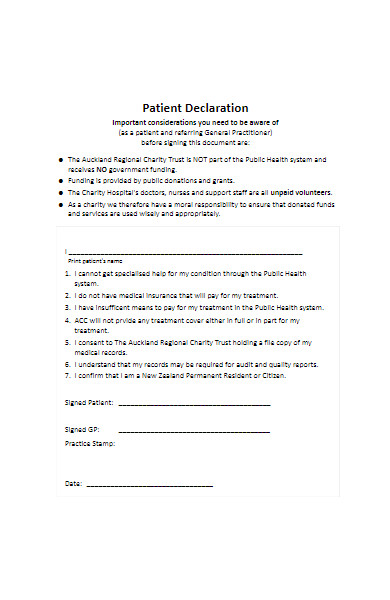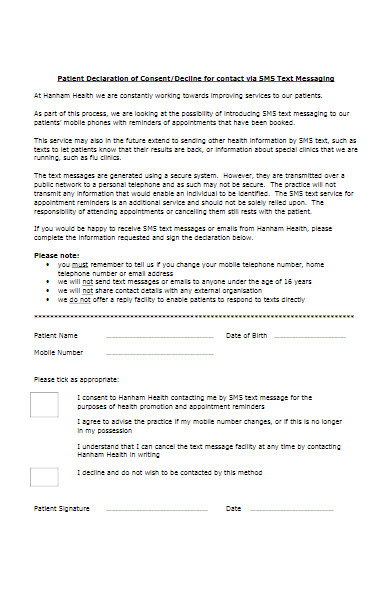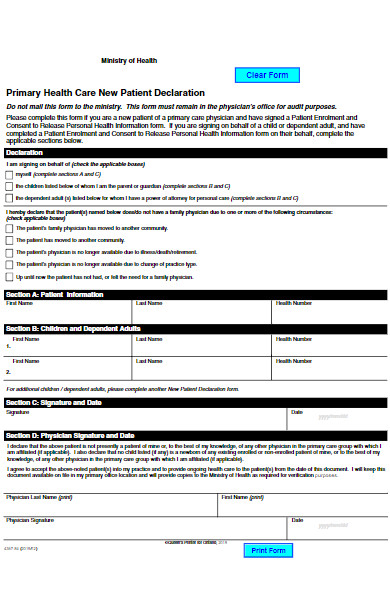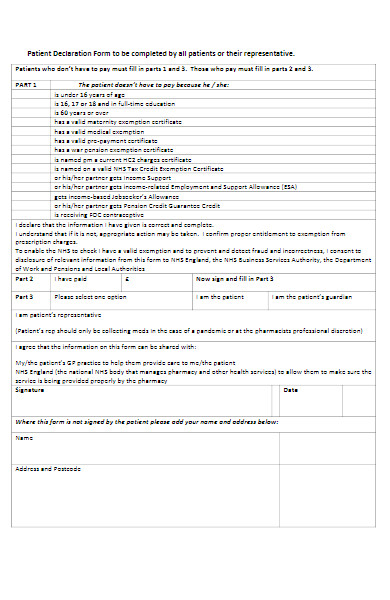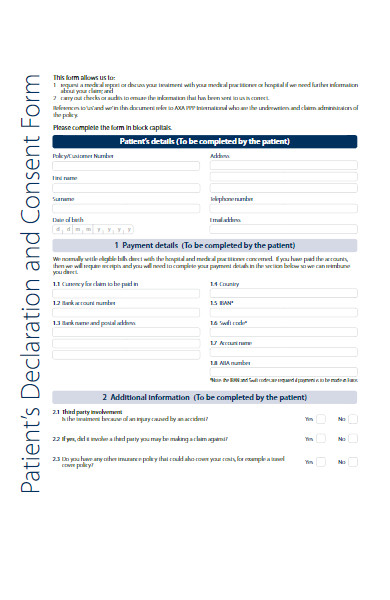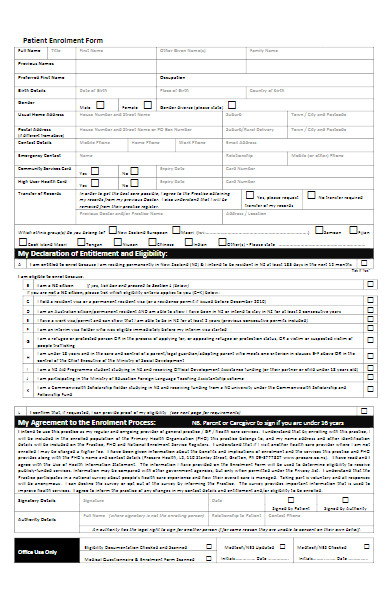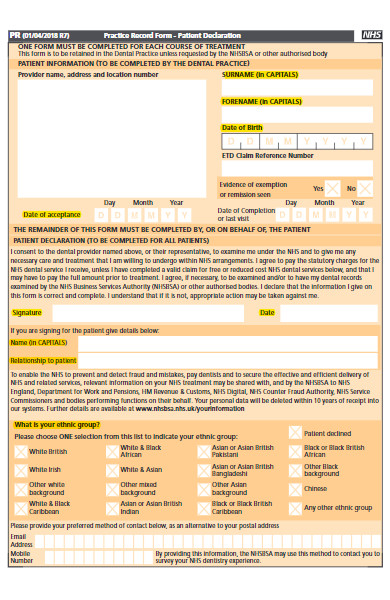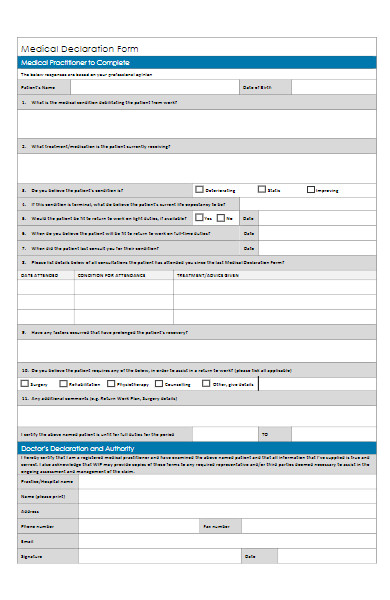A Patient Declaration Form acts as a pivotal communication tool between healthcare providers and patients, encapsulating vital information and consents about treatments, procedures, and confidentiality. This significant document comes in various types and formats, tailoring to diverse healthcare contexts and patient needs. Crafting such a form involves a meticulous understanding of both medical and legal aspects to ensure comprehensiveness and compliance. Let’s delve into its meanings, types, real-world examples, a step-by-step creation guide, and pro tips to gain a thorough understanding.
What is a Patient Declaration Form? – Definition
A Patient Declaration Form is a document that patients use to provide crucial information and affirm their understanding and consent regarding a particular medical procedure, treatment, or policy. It ensures that the patient acknowledges and agrees to certain conditions, thereby legally safeguarding both the patient and the healthcare provider. The form might include details about the patient’s medical history, acknowledgment of receiving specific information, and confirmation of understanding risks and policies related to a procedure or treatment. This becomes a crucial part of a patient’s medical record, ensuring transparency and informed consent throughout the healthcare journey.
What is the Meaning of the Patient Declaration Form?
The Patient Declaration Form primarily serves as a formal communication tool where patients affirm certain information or understanding regarding healthcare processes, treatments, or policies. It typically involves declarations regarding the acknowledgment of procedural risks, understanding of treatment implications, consent for undergoing specific medical interventions, or providing a detailed medical history. These printable form is essential in ensuring that the patient is fully informed and consents to the forthcoming healthcare actions, while also protecting healthcare providers legally by documenting that comprehensive information has been provided and acknowledged by the patient.
What is the Best Sample Patient Declaration Form?
Section 1: Patient Details
- Full Name: ___________________________________
- Date of Birth: //______
- Address: _____________________________________
- Contact Number: ____________________________
- Email Address: _____________________________
Section 2: Treatment Details
- Name of Procedure/Treatment: _______________________
- Date: //______
- Name of Physician: ________________________________
Section 3: Declaration and Consent I, the undersigned, declare that:
- I have been informed about the nature, purpose, potential risks, and benefits of the procedure/treatment.
- I have had the opportunity to ask questions and all my questions have been answered satisfactorily.
- I have been made aware of alternative treatments available.
- I voluntarily consent to proceed with the procedure/treatment.
Section 4: Patient Acknowledgment
- Signature: _______________________
- Date: //______
Section 5: Parent/Guardian (if the patient is a minor)
- Full Name: ________________________
- Relationship to Patient: ____________________
- Signature: _______________________
- Date: //______
Section 6: Physician’s Acknowledgment I confirm that I have explained the procedure/treatment, its risks, benefits, and alternatives to the patient and believe that the patient has understood and given their informed consent.
- Signature: _______________________
- Date: //______
Remember: The actual form should be developed in alignment with legal counsel to ensure all necessary and specific components are included, satisfying all relevant local, state, and federal regulations. Further, the form should be easy to read and comprehend, and it should be accessible in all the ways your patients might need it (e.g., in print, online, in different languages, etc.). For visual coherence, incorporating your institution’s logo and using its color scheme can provide a professional appearance and foster trust.You should also take a look at our Patient Information Forms.
FREE 10+ Patient Declaration Forms in PDF
11. Patient Health Declaration Form
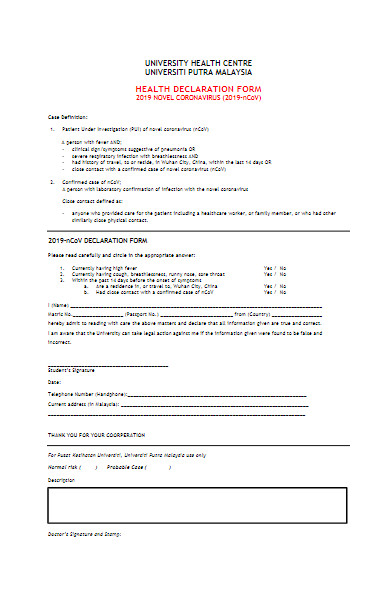
Why is it necessary to fill out a Patient Declaration Form?
Filling out a Patient Declaration Form is crucial for several pivotal reasons within healthcare settings, ensuring both medical practitioners and patients are safeguarded through a clear, documented understanding of the medical procedures and consent:
- Informed Consent:
- The form serves as a document that proves patients have been informed about the procedure, potential risks, and alternatives, and they consent to go forward with an understanding of all this information.
- Legal Protection:
- Both the healthcare providers and the patients are provided with a layer of legal protection. The form can serve as a legal document that confirms that the patient willingly agreed to the treatment after being properly informed, safeguarding medical professionals against legal repercussions.
- Patient Autonomy:
- It respects patient autonomy by ensuring they are an active participant in decisions regarding their health and treatment. The form demonstrates that they are aware and in agreement with the course of action.
- Clinical Communication:
- It fosters transparent communication between the healthcare provider and the patient, ensuring all procedures, risks, and alternatives are openly discussed and understood.
- Medical History Documentation:
- It serves as a part of the patient’s medical history, which might be critical for future healthcare provision and any subsequent treatments or follow-ups.
- Ethical Practice:
- The form is a reflection of the healthcare provider’s commitment to ethical practices by ensuring that all medical interventions are carried out with full patient awareness and consent.
- Decision Making:
- It assists patients in making informed decisions regarding their health and treatment, providing a space for them to understand, ask questions, and agree or disagree with a proposed course of action.
- Risk Management:
- It acts as a risk management tool for healthcare providers, as it contains evidence of communication, information provision, and consent, which is vital if there’s a discrepancy or issue in the future.
- Procedure Validation:
- It validates that a procedure or treatment is conducted legally and ethically, ensuring regulatory compliance within healthcare practices.
In essence, a Patient Declaration Form is a comprehensive tool that bridges clear communication, legal safety, ethical validation, and patient autonomy in the sphere of healthcare services. Our Patient Registration Form is also worth a look at
What information is typically required on a Patient Declaration Form?
A Patient Declaration Form is crucial for obtaining informed consent and maintaining transparent communication between healthcare providers and patients. While specific details might vary, typical information required on such a form includes:
- Patient Information:
- Full name
- Date of birth
- Address
- Contact number
- Email address
- Procedure Details:
- Name and description of the procedure
- Purpose of the procedure
- Name of the healthcare provider performing it
- Risks and Benefits:
- Detailed explanation of potential risks
- Expected benefits from the procedure
- Alternatives:
- Explanation of alternative procedures or treatments
- Comparative benefits and risks
- Confidentiality Assurance:
- Statement regarding the privacy and confidentiality of the patient’s information and records
- Patient Rights:
- Explanation of the patient’s rights, including the right to withdraw consent at any point
- Information about whom to contact with questions or concerns
- Consequences of Non-Treatment:
- Detailed information about what might happen if the patient opts not to undergo the procedure or treatment
- Acknowledgment of Understanding:
- A statement where the patient acknowledges that they understand the procedure, its risks, and alternatives
- Consent to Proceed:
- A statement where the patient consents to the procedure after understanding all provided information
- Signature Section:
- Space for the patient’s signature
- Date
- Witness signature and date (if applicable)
- Provider’s Assurance:
- A statement from the healthcare provider ensuring that the patient understands the procedure and all related aspects
- Provider’s signature and date
- Additional Information:
- Any relevant notes or additional information that pertains to the specific medical procedure or the patient
- Emergency Contact:
- Name, relationship, and contact information of an emergency contact person
- Insurance Details:
- Patient’s insurance provider and policy number
The exact contents may vary depending on the healthcare provider, the type of procedure, and legal or regulatory requirements. Always ensure that the form is compliant with healthcare laws and regulations applicable in the respective region or country.
How is the data from Patient Declaration Forms utilized by healthcare providers?
Data from Patient Declaration Forms is pivotal in numerous aspects of healthcare management and provision. It enables healthcare providers to ensure safety, legality, and efficacy in medical practice while respecting patient autonomy and ensuring transparent communication. Here’s a breakdown of how this data is typically utilized:
- Informed Decision Making:
- Ensures that healthcare providers understand the patient’s medical history and consent, facilitating safe and personalized care.
- Legal Compliance and Protection:
- Acts as a legal document, affirming that the patient has been informed and has consented to the procedure, thereby safeguarding providers against legal disputes related to informed consent.
- Procedure Planning:
- Aids healthcare professionals in planning and executing medical procedures with awareness about the patient’s medical history, allergies, and specific health risks.
- Communication:
- Enhances communication between healthcare professionals by providing crucial patient information that might be pertinent to specialists, anesthetists, or surgeons involved.
- Risk Management:
- Minimizes risks associated with medical procedures by ensuring that healthcare providers are informed about potential allergies, pre-existing conditions, or other patient-specific risk factors.
- Patient Management:
- Assists in managing patient flow and scheduling, ensuring that only consenting patients are scheduled for procedures.
- Audit and Quality Assurance:
- Used for internal audits, research, and quality assurance to analyze the efficacy of healthcare provision and to make necessary adjustments for enhancing care quality.
- Billing and Insurance Processing:
- Facilitates accurate billing and insurance claim processing by providing documented evidence of performed procedures.
- Data Analysis and Research:
- Non-identifiable data may be used (in compliance with data protection regulations) for research purposes and to analyze trends, which can inform healthcare policy and practice.
- Emergency Situations:
- Enables healthcare providers to make informed decisions in case of any adverse events or emergencies during a medical procedure.
- Post-Procedure Follow-Up:
- Guides follow-up care and communication with patients, ensuring that subsequent treatments, if necessary, are coherent with the initial procedure and patient’s health status.
- Patient Education and Engagement:
- Acts as a record that can be referred back to when educating the patient about the procedure and expected outcomes.
- Regulatory Compliance:
- Ensures that healthcare providers adhere to statutory and regulatory requirements related to patient consent and data management.
Data from Patient Declaration Forms must always be managed, stored, and utilized in strict compliance with data protection laws such as the Health Insurance Portability and Accountability Act (HIPAA) in the U.S., or the General Data Protection Regulation (GDPR) in Europe, ensuring confidentiality and security in data handling and sharing.In addition, you should review our Patient Forms.
Why do I need to fill out a Patient Declaration Form?
Filling out a Patient Declaration Form is pivotal in a healthcare context for several reasons. Firstly, it ensures that the healthcare providers are well-informed about your medical history, allergies, and other vital health-related information, which can significantly influence the quality and safety of the care provided. Secondly, the form aids in the accurate recording and management of patient data, which is essential for any subsequent visits or consultations. Additionally, the information furnished helps healthcare practitioners make informed decisions regarding your treatment plans, potential interventions, and manage risk effectively. It also safeguards the healthcare provider legally and ensures that they are acting in line with your known health preferences and requirements. Finally, these option forms assist in maintaining a structured and systematic approach to patient data management, which is crucial for healthcare research, planning, and service delivery optimization.
How secure is the information provided on a Patient Declaration Form?
The security of the information provided on a Patient Declaration Form largely depends on the healthcare provider’s data protection and storage protocols. In many countries, there are strict regulations, such as the Health Insurance Portability and Accountability Act (HIPAA) in the United States, which mandate the safeguarding of patient data through various administrative, physical, and technical safeguards. Such legislation often requires healthcare entities to:
- Protect Information: Implement policies and procedures that restrict access to, protect the integrity of, and guard against unauthorized access to patient information.
- Data Encryption: Employ encryption and other secure data transmission methods when sending or sharing data electronically.
- Access Control: Implement strategies to ensure that only authorized personnel have access to patient data, like using secure passwords, biometric data, or smart cards.
- Physical Security: Secure the physical locations where data is stored, whether in file cabinets or on servers, to prevent unauthorized access.
- Training: Ensure staff is trained to understand the importance of patient data privacy and are aware of the procedures and protocols to follow to ensure its security.
- Data Backup: Ensure that data is regularly backed up and that backup recovery processes are in place to protect against data loss.
Despite these precautions, it’s crucial for patients to inquire about and understand the data protection protocols of their healthcare provider, as adherence to these practices can vary. Always ensure to share your data only with trustworthy and compliant healthcare entities.
Is a Patient Declaration Form the same as a consent form?
No, a Patient Declaration Form and a consent form are not the same, although they are related concepts in the healthcare setting and might sometimes be used interchangeably in certain contexts, which can create confusion. Here’s a brief breakdown of each:
- Patient Declaration Form This is a document that typically encompasses details about a patient’s personal, medical, and insurance details. It may include the patient’s health history, current health status, and other relevant information. The purpose of this form might be to declare the patient’s current health status, understanding of certain policies, or acknowledgment of receiving specific information.
- Consent Form A consent form in the healthcare setting is generally utilized to gain a patient’s approval before conducting specific procedures or treatments, or to authorize the sharing of their medical information with third parties. The aim is to ensure that the patient understands and agrees to the potential risks, benefits, and alternatives involved.
While both forms are crucial in ensuring clear communication and safeguarding patient rights, they serve distinct purposes. A Patient Declaration Form often serves to record and acknowledge the patient’s status and understanding, whereas a consent form secures permission for specific actions regarding the patient’s health and data.
Is it possible to fill out a Patient Declaration Form online or digitally?
Yes, it is possible to fill out a Patient Declaration Form online or digitally in many healthcare settings. The advancement of digital technology and the need for contactless and remote processes, especially accentuated during the COVID-19 pandemic, have propelled the adoption of online and digital forms in healthcare.
The availability of an online or digital Patient Declaration Form can depend on the healthcare provider’s technological capabilities and the platform they use. When available, patients can fill out the form using either a computer or a mobile device, ensuring convenience and flexibility. Such digital transformation not only reduces the use of paper but also ensures that the data can be seamlessly integrated into the patient’s electronic health records.
Always ensure that the platform used to fill out and submit the Patient Declaration Form online adheres to data protection regulations and uses encryption to safeguard the data transmission.You may also be interested in our Employee declaration form.
Can I request to view or obtain a copy of my Patient Declaration Form?
Yes, patients generally have the right to request to view or obtain a copy of their Patient Declaration Form. Laws like the Health Insurance Portability and Accountability Act (HIPAA) in the United States give patients the right to access their own health information, which would include forms they have filled out and submitted. Different countries and regions have varying regulations, but most uphold the principle of patient access to their own health records.
When you request a copy of your Patient Declaration Form, healthcare providers may give you physical or digital access to it. However, keep in mind that the exact procedure, time-frame to access, and any potential costs can depend on the local regulations, as well as individual healthcare facility policies. It’s always advisable to check the specific process and requirement details with your healthcare provider. Always ensure that your request is documented, and in some cases, you might need to submit a formal, written request to obtain the records.
How to Create Patient Declaration Form?
Creating a Patient Declaration Form involves understanding the medical, legal, and personal informational needs that must be addressed within the document. Here’s a step-by-step guide on how to create a Patient Declaration Form:
Step 1: Understand the Legal Requirements
- Identify the legalities and regulations relevant to patient information in your region.
- Ensure compliance with healthcare data protection laws, such as HIPAA in the U.S.
Step 2: Define the Purpose
- Clearly outline the purpose of the form.
- Identify all information that needs to be declared by the patient.
Step 3: Structuring the Form
- Header: Include the name of the healthcare facility and logo.
- Title: Clearly mention “Patient Declaration Form”.
- Patient Details: Space for name, date of birth, contact details, and any identifying information.
Step 4: Inclusion of Necessary Sections
Medical History Section
- Questions related to patient’s medical history, allergies, and ongoing treatments.
Declaration of Current Health Status
- Include questions regarding current symptoms, recent travels, or exposure to contagious diseases.
Consent and Compliance
- Space where patients acknowledge and confirm the accuracy of their provided information.
- A statement where they consent to abide by the healthcare facility’s guidelines and policies.
Step 5: Privacy Assurance
- Include a privacy statement, ensuring that the data provided will be stored and handled securely and confidentially.
Step 6: Legal Declarations and Signatures
- Include a section where the patient declares that the information provided is accurate.
- Provide space for the patient’s signature and date.
Step 7: Design Considerations
- Ensure the form is easy to read and fill out.
- Use clear and straightforward language.
- Ensure all sections are clearly separated and legible.
Step 8: Review and Legal Approval
- Have the form reviewed by healthcare professionals for accuracy and completeness.
- Seek approval from a legal expert to ensure the form adheres to all laws and regulations.
Step 9: Test the Form
- Conduct a trial run with a small group to ascertain the form’s efficiency and comprehensiveness.
- Make necessary adjustments based on feedback.
Step 10: Finalization and Distribution
- Implement the form into your healthcare facility’s patient intake process.
- Ensure the form is easily accessible both digitally (if applicable) and in print format.
Step 11: Data Management
- Ensure that the collected data is stored securely, and establish a system for easy retrieval when needed.
- Comply with data retention policies and ensure safe disposal/deletion when data is no longer needed.
Remember to regularly review and update the Patient Declaration Form as per any changes in legal or healthcare protocols. This ensures the document remains compliant and continues to serve its intended purpose effectively.
Tips for creating an Effective Patient Declaration Form
Creating a proficient Patient Declaration Form is pivotal in obtaining comprehensive and accurate information from patients, ensuring a smooth process for both them and healthcare providers. Below are some strategic tips:
1. Maintain Simplicity:
Ensure clear and concise language and avoid medical jargon to make the form easy to understand for all patients.
2. Organized Structure:
Lay out the form in a logical sequence, moving from general to specific queries regarding personal and medical details.
3. Ensure Privacy:
Clearly inform patients about the usage and safeguarding of their data, underlining your commitment to privacy.
4. Accessibility and Inclusivity:
Make the form accessible to people of all abilities and provide it in multiple languages if needed.
5. Clearly Indicate Mandatory Fields:
Mark all the required fields clearly and provide guidelines for any specific information needed.
6. Legal Compliance:
Ensure the form abides by regional and international laws regarding healthcare and data protection.
7. Digital and Physical Accessibility:
Provide options for both digital and physical form submissions, ensuring accessibility for all patients.
8. Provide Contact Details:
Mention clear contact details for patients who might need assistance or have queries regarding the form.
9. Space for Additional Details:
Allow space for extra comments or information that a patient might want to share.
10. Design for Clarity:
Choose a clean design with easy-to-read fonts and clearly distinguishable sections.
11. Ensure Secure Data Handling:
Ensure that the data submitted through the form is securely handled and stored.
12. Implement Data Verification:
In digital forms, include mechanisms to verify the accuracy and completion of data.
13. Include a Consent Section:
Ensure that there’s a section for patients to confirm that they understand and agree to the terms outlined.
14. Usability:
Test the form for usability and make necessary adjustments to ensure it is user-friendly.
15. Feedback Mechanism:
Include a section for feedback about the form to enhance and refine it continually.
16. Provide Clarity on Next Steps:
Clearly outline what will happen post-submission and specify any subsequent steps for the patient.
By focusing on these aspects, your Patient Declaration Form will not only be compliant and efficient but will also provide ease and clarity to patients, thereby optimizing the data collection process for enhanced healthcare provision.
Patient Declaration Forms play a crucial role in healthcare, bridging communication between providers and patients by capturing vital information and consent. Ensuring clarity, legality, and accessibility in these forms is pivotal, safeguarding rights and data on both ends. Effective creation and management of these fillable forms, whether digitally or on paper, enhance organizational efficiency and patient experience, adhering to healthcare compliance and facilitating informed, transparent care provision.
Related Posts
FREE 3+ Patient Sign In Sheets in PDF MS Word
FREE 11+ Sample Patient Complaint Forms in PDF Word
FREE 7+ Patient Satisfaction Questionnaire Forms in PDF Ms Word
FREE 10+ Sample Patient Satisfaction Questionnaire Forms in PDF ...
FREE 10+ Feedback Forms for Nursing PDF
FREE 23+ Patient Release Forms in PDF MS Word
FREE 8+ Sample Health Insurance Claim Forms in PDF MS Word
FREE 8+ Patient Complaint Forms in PDF MS Word
FREE 6+ New Patient Intake Forms in PDF MS Word | Excel
FREE 3+ Patient Intake Forms in PDF MS Word
FREE 52+ Declaration Forms in PDF MS Word | XLS
FREE 6+ Medical History Forms in PDF MS Word | Excel
FREE 11+ Sample Medical Claim Forms in PDF MS Word | Excel
FREE 10+ Patient Information Forms in PDF Ms Word
FREE 5+ Patient Counseling Forms in PDF Ms Word
